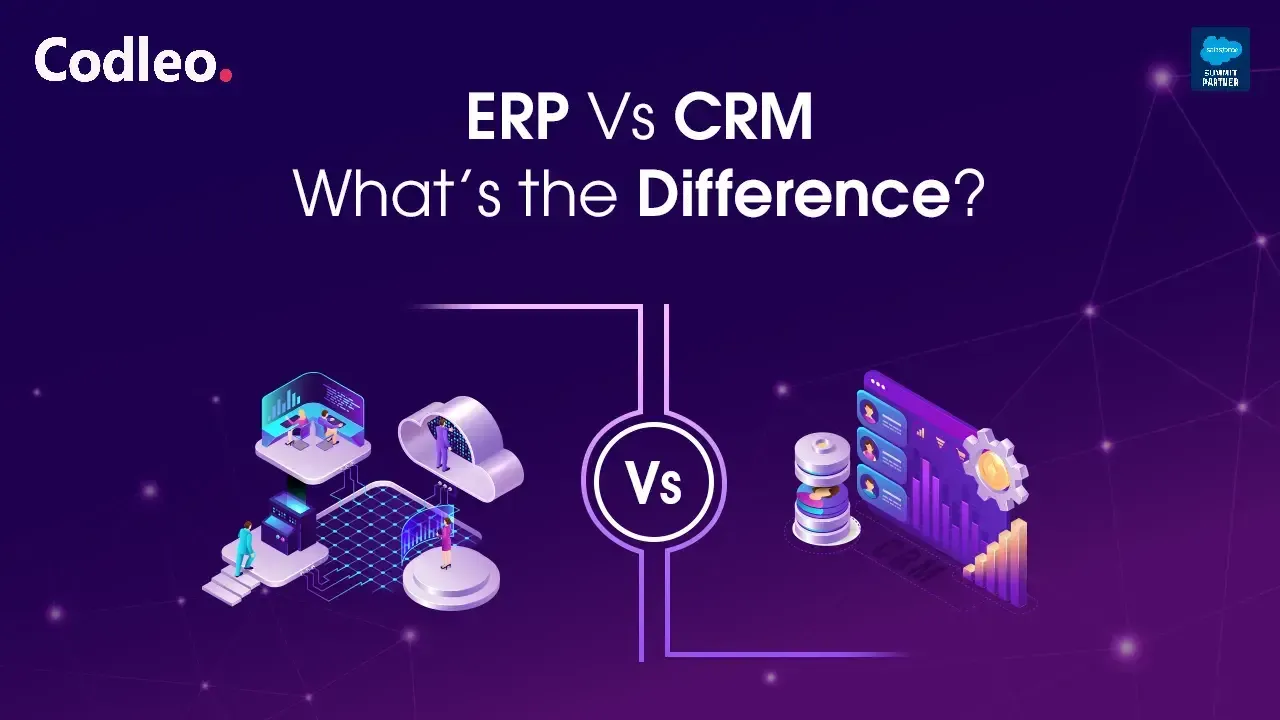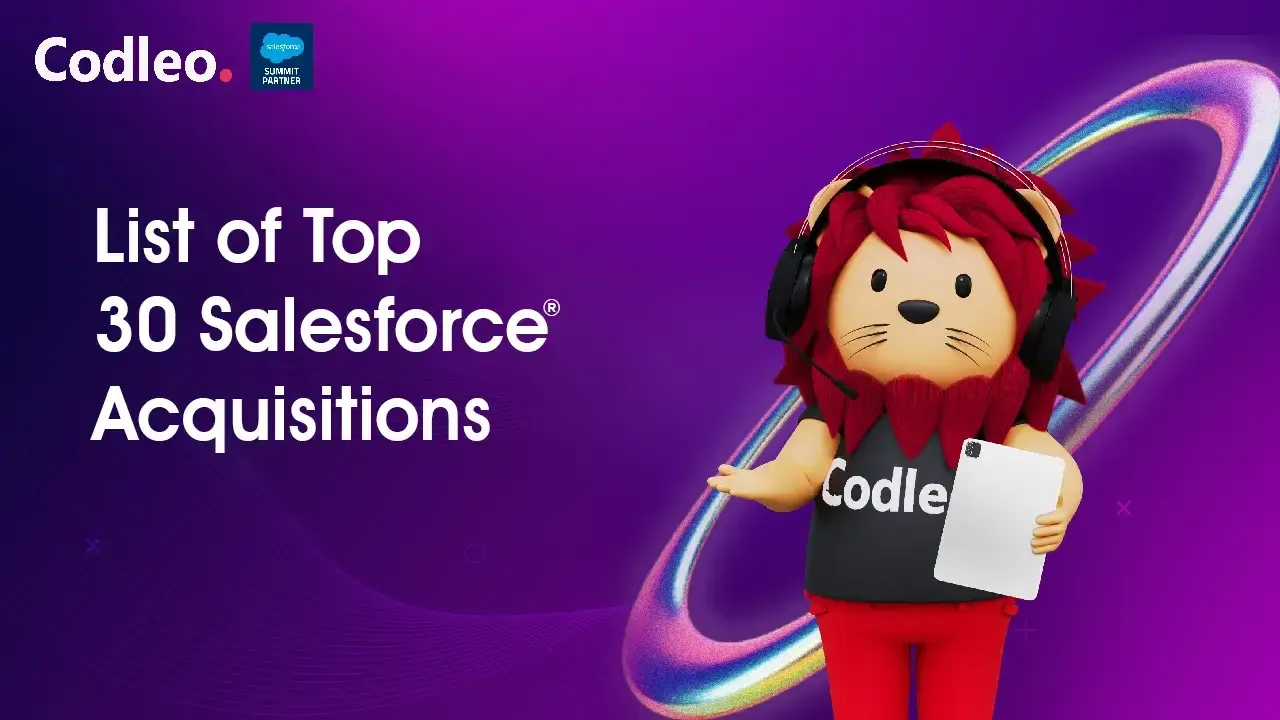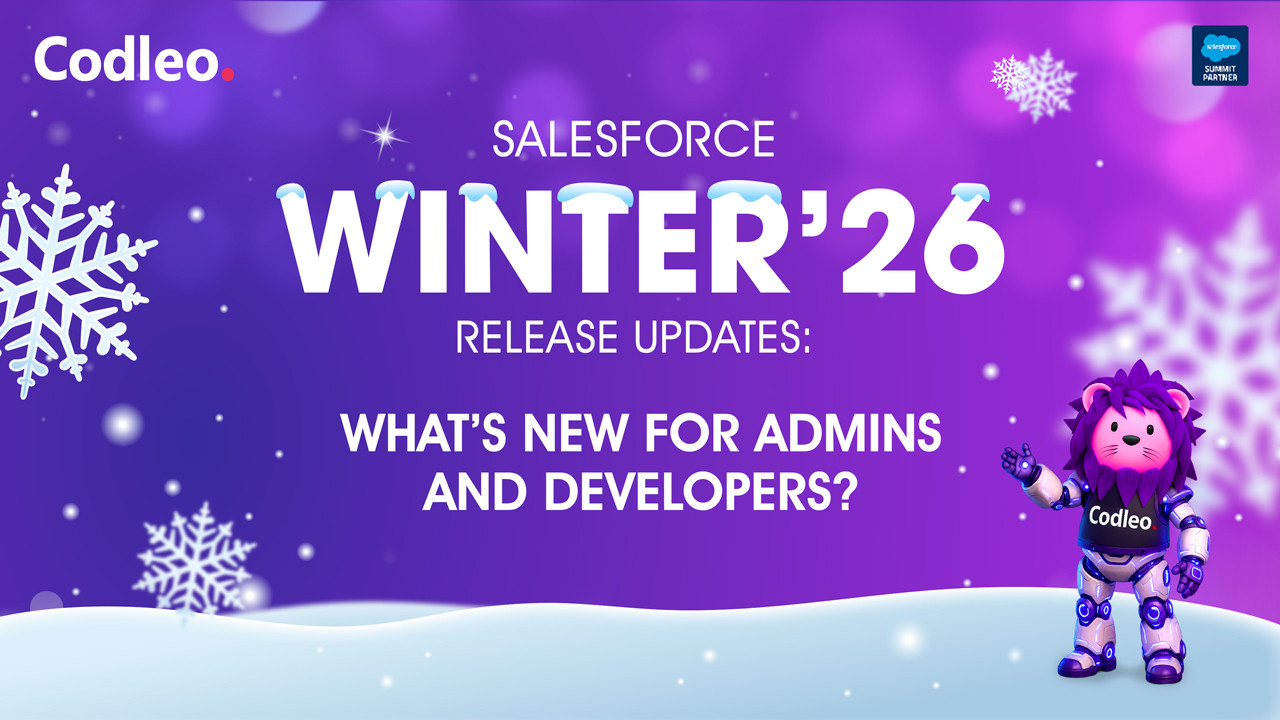Publish date:
The future of technology is clearly AI. But have we hit its limits yet? Probably not. Salesforce continues to demonstrate that AI can further enhance business operations.
Salesforce, A platform called Agentforce is used to create AI agents that function similarly to virtual coworkers. With their business expertise, these agents can respond to inquiries, take action, and finish tasks, offering round-the-clock assistance to staff members and clients. Agentforce enhances accuracy, efficiency, and customer satisfaction by automating repetitive tasks and providing ongoing support. However, to utilize AI agents effectively, companies must plan carefully and remain flexible.
Unlike traditional IT projects, AI projects work best when they start small with pilot tests and improve based on feedback. This method reduces risk and provides value quickly in short cycles, rather than through a single large rollout.
Before starting an Agentforce project, ensure you have all the necessary materials. It means you require the proper Salesforce licenses, including access to Customer 360 and the Agentforce platform. You should also integrate with the relevant data sources.
To get the best from Salesforce’s AI features, you need an experienced Agentforce implementation partner. Here are some of the top Agentforce implementation partners:
What Is Agentforce?
Agentforce is Salesforce’s platform for AI agents that work independently and integrate directly into your business processes.
Agentforce agents connect directly to your business systems, unlike standalone tools like ChatGPT or Gemini. They can start and manage workflows, update records, and perform complex tasks across different applications to achieve real results for your business.
Why Do I Need to Implement Agentforce?
Companies use Agentforce to eliminate delays in their operations, expedite response times, and free their teams from repetitive tasks. It enables teams to focus on their most important work. The platform helps bridge the gap between customer expectations and what the business can deliver, making interactions feel both personal and efficient.
How Do Agentforce AI Agents Work?
To start, set up each agent with its specific tasks, which include what data they can access and their limits. When a trigger occurs, such as a record change or a user request, the agent assesses the situation, selects the most suitable action, and completes the task automatically.
Agentforce agents work independently. They can create new tasks, predict what to do next, and change the user interface based on user feedback. The Agentforce platform utilizes advanced conversational AI to analyze data and make decisions, much like experienced human team members do.
What Tasks Can Agentforce Perform?
Agents can handle customer support requests, complete transactions, and qualify leads. They can also perform many other business tasks. It makes repetitive manual work easier, faster, and more efficient.
Agents operate independently and are available 24/7. Connected to the Salesforce platform, they access vital data, including workflows and customer information, enabling accurate and personalized results. You set the rules for their behavior to ensure compliance with legal and brand standards.
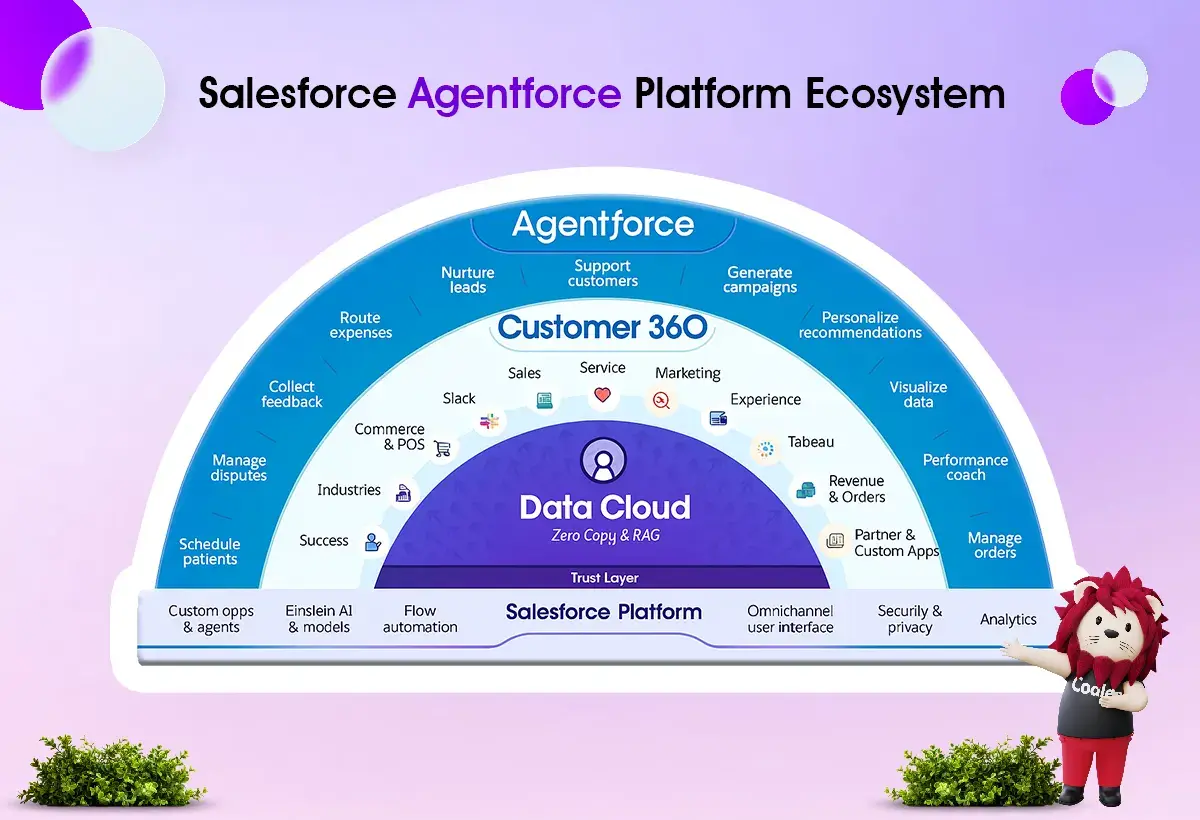
How to Implement Agentforce Successfully
You can either set it up yourself or collaborate with an experienced implementation partner if you wish to use Agentforce. Every choice has advantages and disadvantages. While doing it yourself gives you total control and may result in upfront cost savings, partnering can offer professional assistance and expedite the process. Select the option that best aligns with your team's skills, budget, and schedule.
Please note that Salesforce offers implementation and professional development services; however, these can be expensive. The Agentforce support team can help you buy the right Agentforce agents for your business. However, once you have the platform, you will need to manage it on your own or work with an Agentforce implementation partner, which we will discuss next.
Salesforce offers pre-built agents for several services. These include agents for Service Cloud, which helps with customer support cases, and the Merchant Agent, designed to optimize online storefronts. There are also two agents for Sales Cloud: the Sales Development Representative and the Sales Coach agent. Keep in mind that you will need to configure these pre-built agents to use them effectively in your business.
How to Choose the Right Agentforce Implementation Partner?
To make the right choice of an Agentforce implementation partner and make the collaboration really fruitful, here are the criteria you should consider:
How to Verify If Your Agentforce Implementation Partner Is Salesforce-Certified on AppExchange
When using Agentforce, we recommend partnering with certified Salesforce companies listed on AppExchange. These companies have received official approval from Salesforce and hold active certifications that show they meet technical requirements. If a partner has their own app on AppExchange, it shows they have proven skills in Salesforce development. It ensures that your implementation follows best practices and Salesforce standards.
Is the Partner Experienced with Salesforce Implementation Success?
Top Agentforce implementation partners have broad experience with various Salesforce cloud projects and consistently deliver them on time.
Does Your Partner Hold Specialized Agentforce Certifications and AI Expertise?
Top partners have teams with advanced skills in designing and using AI agents. Many of them, like Codleo, also offer a broader range of AI expertise beyond just Agentforce. It includes custom tools for managing documents with AI, chatbots, and enhanced search functions, which are provided as needed.
Has the partner's industry experience been demonstrated through successful client outcomes?
Excellence is proven through Salesforce partner awards and clear client success stories. Partners need to show the results or improvements that their work has created.
Will the Partner Align with Your Time Zone and Collaboration Needs?
It's a good idea to have a partner in your time zone or a company that provides support in multiple time zones with local language assistance. It helps create convenient delivery options, including onshore, nearshore, and offshore resources, for global growth.
Does the partner specialize in Salesforce or in AI and automation?
Both. Leading Agentforce implementation partners develop their own tools and ready-made solutions tailored to various industries, extending beyond standard deployments. They also invest regularly in research and development to expand what’s possible, so that you will work with an innovator and leader in the AI industry.
Agentforce Implementation Partner or In-House Team: Which Is the Best Choice?
Implementing Agentforce is a complex process. It affects all of the company’s business data, infrastructure, and customer-facing workflows.
At Codleo, we have over 12 years of experience with Salesforce. We've seen many companies spend hundreds of thousands of dollars trying to set up Salesforce on their own. Often, they struggle and ultimately turn to an expert partner like us for help with the configuration.
In 85% of cases, you will need an Agentforce implementation partner. It will help you save time, budget, effort, and resources.
Still, let’s explore your options to make a truly informed decision.
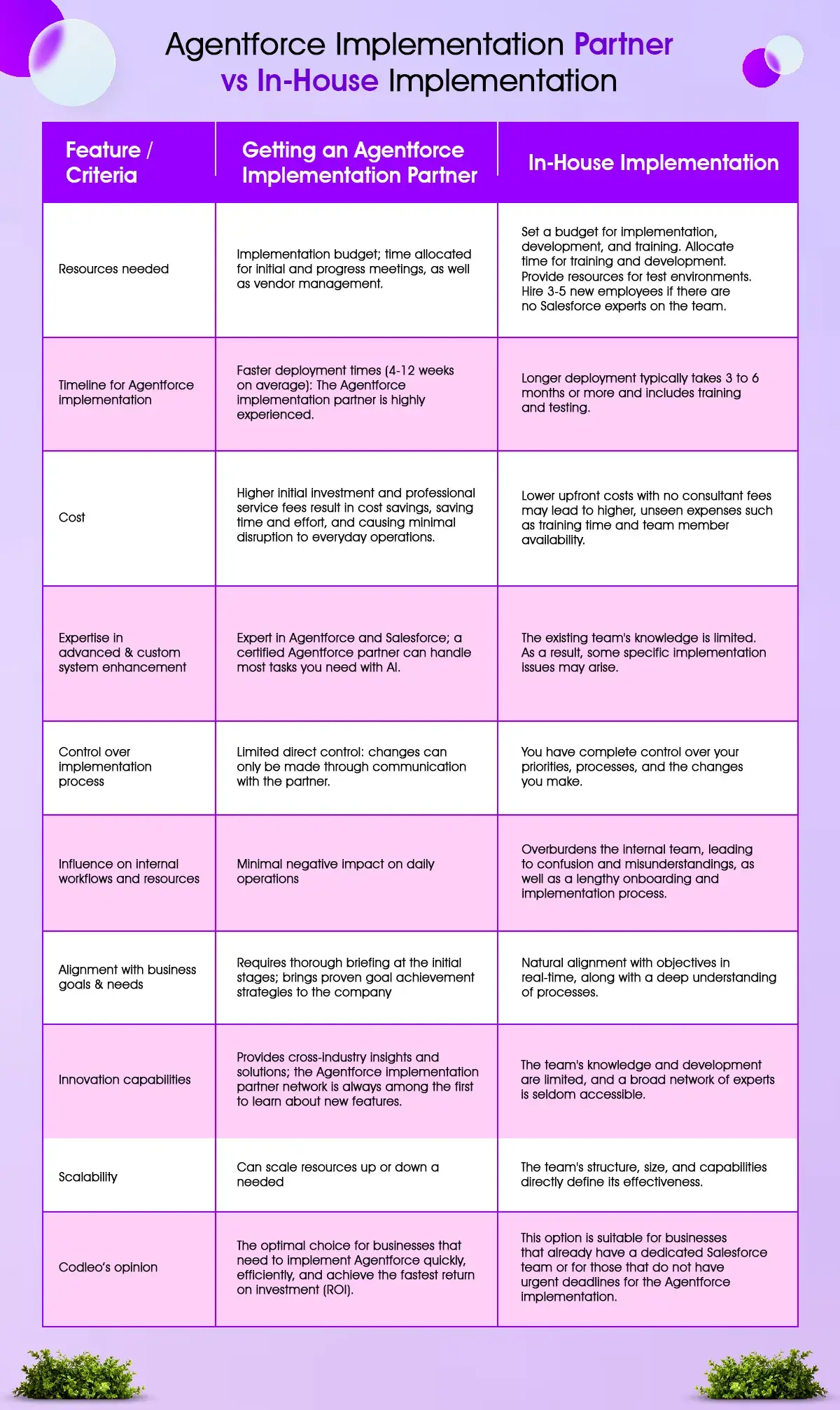
How Long Does Agentforce Implementation Take?
Here’s a simple plan to help you confidently implement Salesforce Agentforce. Each phase is designed to build progress, lower risks, and ensure a successful rollout of the AI agent.
Phase 1: Project Kickoff and Alignment
-
Key Activities: The project kicks off with a meeting to define the vision and scope. The team will identify key stakeholders, discuss the main goals, and outline the use cases for the AI agent.
-
Stakeholder Involvement: A kickoff meeting is led by an executive sponsor and a project manager. They involve department heads or business leads whose teams will use the AI agent to discuss their needs and confirm their support. IT staff and Salesforce platform owners also participate in reviewing the technical requirements.
-
Expected Deliverables: The team creates a clear project plan. It usually includes specific project goals, measures of success, a list of AI use cases, key roles and responsibilities, and a rough timeline.
-
Impact on Operations: At this early stage, daily operations remain essentially unchanged. Most of the work involves planning and meetings. Except for the time stakeholders spend in discussions, everything else continues as usual. This preparation helps ensure everyone is on the same page and paves the way for a smooth implementation.
Phase 2: Use Case Definition and Requirements
-
Key Activities: With leadership support and the project scope clear, phase 2 centers on profound discovery. The team conducts workshops to identify and rank real-world applications for the AI agent, including answering customer questions, automating data entry, and assisting with sales research. They also gather detailed functional requirements for each chosen use case.
For instance, we must specify the duties the agent will carry out, the information it needs, and the metrics by which its performance will be evaluated. To guarantee a smooth integration, we must also identify the data sources and system integrations, such as knowledge bases or CRM records. -
Stakeholder Involvement: Business process owners and experts play a crucial role in defining the agent’s tasks. They identify problems and key activities that need attention. Salesforce admins and AI specialists then utilize this information to develop specific skills for the agent.
-
Expected Deliverables: By the end of this phase, the team will have a list of use cases, precise requirements, and set key performance indicators (KPIs). These can be written as user stories or process flows. The team may also create a feature backlog or a phased roadmap, especially if there are multiple use cases to consider.
-
Impact on Operations: The effect on operations is still small, but alignment with our strategy is improving. Stakeholders can see how the agent will assist them in their daily tasks, which helps set the stage for better adoption in the future.
Phase 3: Solution Design and Architecture
-
Key Activities: This phase transitions from planning to technical design. Salesforce architects and developers will create the Agentforce architecture. They will determine how the AI agent operates within Salesforce, which systems it will integrate with, and how users will interact with it. The team will outline conversation flows and user interactions, as well as map integrations, such as connecting to Salesforce Data Cloud. They will also set clear limits on what the agent can and cannot do. Additionally, they will define governance rules and safety controls to ensure compliance.
-
Stakeholder Involvement: The technical team guides business analysts to check workflows. The security and compliance teams review the design to ensure the agent’s permissions align with our internal policies.
-
Expected Deliverables: This document outlines the solution design, including the system's structure, data flow, conversation logic, and any technical requirements. It acts as the guide for development.
-
Impact on Operations: We won't make any immediate changes to operations; however, this phase will help us establish a strong technical foundation. It will make future implementations smoother and reduce risks.
Phase 4: Agent Configuration and Development
-
Key Activities: This phase focuses on building the agent in a Salesforce sandbox. The team configures the agent’s topics, actions, and knowledge according to the design. They also establish any necessary connections with external systems and train the agent using relevant content to manage real-world business scenarios.
-
Stakeholder Involvement: The technical team leads the project, including Salesforce developers and admins. They may ask subject-matter experts to check content or test early versions. Project managers keep all stakeholders informed about the project's progress.
-
Expected Deliverables: By the end of this phase, we will have a basic version of the Agentforce agent ready for testing. This prototype demonstrates how the agent handles everyday tasks, helping us confirm our development plan.
-
Impact on Operations: Currently, there's no impact on live systems; however, a visible prototype creates excitement and prepares stakeholders for the rollout.
Phase 5: Testing and Iteration
-
Key Activities: This stage focuses on testing and improving the AI agent. The team verifies that the agent can accurately complete tasks and provide correct answers while adhering to established limits. They utilize Salesforce’s Agentforce Testing Center to run tests that simulate fundamental interactions, identifying any bugs, unclear prompts, or unexpected behaviors. Then, the team works through multiple test-fix cycles to enhance the agent’s performance and reliability.
-
Stakeholder Involvement: QA analysts and Salesforce admins lead the testing process. Selected business users, such as service agents and sales representatives, may have the opportunity to test the agent in controlled settings and provide feedback to improve usability. We also discuss a technical report that identifies and prioritizes essential improvements based on testing results and user feedback.
-
Expected Deliverables: The team has delivered a “beta” version of the agent along with a testing report. This report lists the issues that have been fixed, the remaining bugs, and the feedback from pilot users that has been used to update the configuration.
-
Impact on Operations: Testing occurs with minimal disruption, either in a sandbox environment or with a small group of users. This phase is essential to ensure the agent works reliably before it goes live. It also helps build trust within the organization, turning early testers into supporters for broader adoption.
Phase 6: User Training and User Acceptance Testing (UAT)
-
Key Activities: More users are being introduced to the team's almost-completed AI agent. To assist users, like call center agents and sales representatives, in learning how to use the agent efficiently, they will host training sessions and demonstrations. They will carry out User Acceptance Testing (UAT) concurrently. It enables real-world interactions between business users and the agent. The group will also make last-minute adjustments, such as refining the wording or adding FAQs that were overlooked.
-
Stakeholder Involvement: During this stage, business end-users play a key role. Training leads conduct sessions, while project administrators and developers assist with testing and resolve any issues that arise. Executive sponsors may also join in to show support and boost morale.
-
Expected Deliverables: The team finishes User Acceptance Testing (UAT) and provides feedback. They get a formal sign-off from business stakeholders and finalize user training materials. It includes updated user guides, FAQs, and any last-minute changes to make the system easier to use, as well as improve response quality based on the tests.
-
Impact on Operations: Keep it simple. Users only need to spend a short amount of time on training. This small effort will lead to easier use later on. As the agent approaches production readiness, excitement builds across teams.
Phase 7: Pilot Launch (Limited Deployment)
-
Key Activities: The AI agent will be introduced in a controlled environment, such as one department or regional office. The project team will monitor its performance in real-life scenarios, focusing on key metrics such as the effectiveness of problem resolution and user satisfaction. They will collect feedback through regular check-ins and promptly address any issues that arise. This careful rollout reduces risks and helps confirm that both the technology and user experience are effective.
-
Stakeholder Involvement: The pilot group will be the primary focus. They will use the agent in their daily tasks and give feedback. The project team will provide support and make real-time improvements. Leadership will closely monitor progress to determine when to proceed with full deployment.
-
Expected Deliverables: The experts will give a clear report on the pilot's performance. This report provides details on how agents were utilized, their success rates, user feedback, and any technical issues that arose. It also notes any minor improvements made during the pilot and recommends whether the agent is ready for a larger rollout.
-
Impact on Operations: The project is limited but effective. Some users start using the agent in their daily tasks and notice productivity improvements. Overall operations remain the same, allowing for a safe way to learn and make changes before expansion.
Phase 8: Evaluation and Optimization
-
Key Activities: Following the pilot, the team assesses the initiative's success using specific metrics. They analyze data and user feedback to identify areas that require improvement. Improvements may include updating knowledge content, modifying escalation processes, or enhancing integrations. A meeting with leadership is held to decide if they are ready for the full rollout.
-
Stakeholder Involvement: Business leaders, pilot users, and technical teams work together closely. Project sponsors assess how the project aligns with the overall strategy and its expected outcomes. Developers make final changes based on their findings.
-
Expected Deliverables: The team will provide a detailed report on the pilot results, based on our success criteria. This report includes updated agent settings that demonstrate our improvements, a list of changes made following the pilot, and a clear recommendation on whether to proceed with full deployment. We also prepared a draft plan for the rollout to guide the next steps.
-
Impact on Operations: We are still working with a small group of pilot users. We are addressing any issues to ensure the wider release is stable and effective. This phase helps build confidence among leaders and ensures we are ready for the next steps.
Phase 9: Full Rollout Planning
-
Key Activities: The team gets ready to launch the project across the organization. They will decide whether to roll it out in phases or all at once. They will also prepare the environment and update communication and training materials. Helpdesk and support processes will be set up. Everyone involved will be informed about their responsibilities.
-
Stakeholder Involvement: Project managers work with different departments. Change managers oversee user communications and training plans. Leaders decide on the timing and share messages to create excitement and ensure everyone is on the same page.
-
Expected Deliverables: The team has a clear rollout plan and timeline ready. They have updated training materials for the remaining users. There is also a support plan that includes help desk documentation and procedures for escalation. The communication materials, such as internal emails and announcements, are complete. All departments involved understand their roles for the go-live.
-
Impact on Operations: During this phase, there will be minimal changes to operations. Internal communication can help build awareness and prepare everyone; however, the real impact will begin when we go live.
Phase 10: Go-Live and Full Deployment
-
Key Activities: The Agentforce agent is now fully set up for all users. The team makes final data updates, activates the system in production, and provides real-time support. They monitor metrics, user activity, and any issues that arise. They quickly apply fixes as needed and closely track early usage statistics.
-
Stakeholder Involvement: All users are now active participants. The support team is ready to respond rapidly. Leaders are promoting the agent’s benefits to encourage use and facilitate easier transitions. If the agent is used with customers, service teams are closely watching the customer experience.
-
Expected Deliverables: The team successfully deployed the AI agent and tracked its performance with clear go-live metrics and a daily log of issues resolved. They held a meeting after the launch to discuss what went well and what could be improved. Now, the project can officially move out of the implementation phase and into regular support.
-
Impact on Operations: The AI agent becomes a noticeable part of daily work. It helps with tasks like looking up data, answering customer questions, and organizing tasks. Some people might need time to adjust, but training and pilot programs can help minimize any disruption. Productivity improvements often become noticeable quickly.
Agentforce License Pricing as a Part of Agentforce Implementation
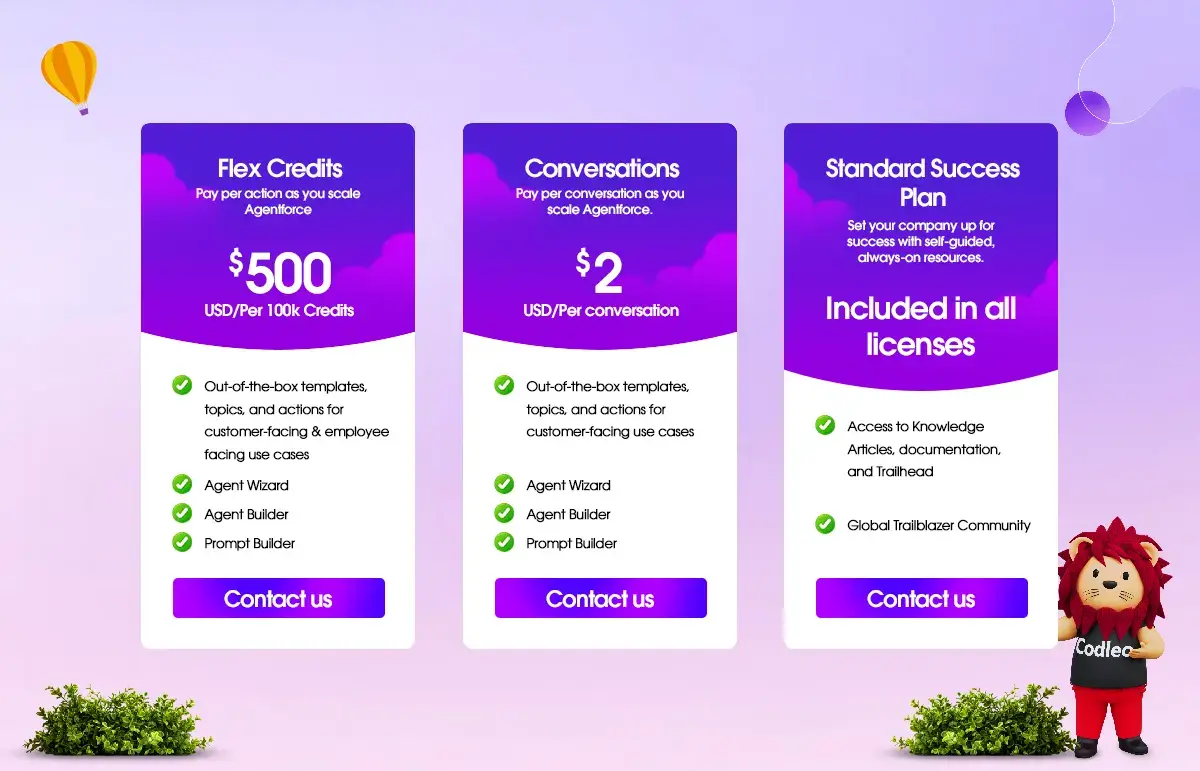
Codleo Consulting
-
Founded: 2019
-
Number of certified Salesforce experts: 180+
-
Rating on AppExchange: 4.8
-
Headquarters: Delhi, India
Codleo is a leading partner for Agentforce implementation. They have over 20 years of experience in customer relationship management (CRM) and more than 12 years in Salesforce consulting. As a Salesforce Summit Partner and a member of the Agentforce Partner Network, Codleo offers complete Agentforce implementation services for businesses of all sizes. Based in Delaware, Codleo operates in five countries and is proud to provide its services worldwide.
Key Strengths:
-
Extensive expertise in various fields, including commercial and residential real estate, capital markets, nonprofit, private equity, venture capital, and more.
-
We have a wide range of projects for Salesforce consulting, implementation, and customization. Our work spans multiple clients across various industries.
-
We are certified members of the Agentforce partner network. Our team has over 150 Salesforce certifications and includes more than 15 Agentforce specialists.
-
We have delivered over 300 Salesforce projects, resulting in hundreds of satisfied clients.
-
We can build AI agents and assistants using the Agentforce platform for specific industry tasks.
-
Get the Dedicated Agentforce package for fast implementation and personalized AI agent creation in just 2-3 weeks for $3,600.
Codleo's team is skilled in Salesforce and has much experience. They offer numerous customization options, making them an ideal partner for businesses seeking to implement Agentforce quickly and with high quality.
Salesforce Agentforce has setup costs. It also charges based on how much you use it.
To use Agentforce in your organization, you need a Salesforce license and Salesforce Data Cloud. The Data Cloud pulls data to help improve your Agentforce AI agent.
You can pay for Agentforce using Flex credits for each action or by paying per conversation. Below is a detailed breakdown of the pricing.
-
Each action taken by Agentforce costs $0.10, which is 20 Flex Credits.
-
You can buy Flex Credits in packages. For example, you can get 100,000 credits for $500.
-
Some Salesforce editions offer free entry-level access. It includes 100,000 Flex Credits for trial use.
Why Codleo Is Your Best Agentforce Implementation Partner
Using Salesforce Agentforce is not just a technology update; it helps your business run faster, smarter, and more efficiently. A step-by-step approach lowers risks, improves results, and keeps everyone on the same page as you introduce AI agents. Each step builds on the previous one to ensure a smooth and successful launch.
Codleo is a trusted Salesforce Summit Partner that can help you every step of the way. We handle everything from planning and setup to training and support, ensuring you get the most out of Agentforce. With Codleo, your AI agents will become dependable digital coworkers, available 24/7 to help your teams and enhance customer experiences. Contact us today for Agentforce consulting services.
Codleo is a leader in using advanced Agentforce and Salesforce solutions.
Our professional services include:
-
AI Consulting Services. If you need expert advice on AI solutions, our consultants offer clear guidance and practical recommendations tailored to your business needs.
-
Unified AI Integration. We set up and customize AI platforms, particularly Agentforce, to integrate seamlessly with your existing systems and technologies. Our goal is to provide the best user experiences.
-
Tailored AI Development. Our team develops custom Salesforce AI solutions tailored to address your organization's specific challenges and goals.
To quickly set up Agentforce, choose the Agentforce Quickstart Package from Codleo. This package helps you deploy essential Agentforce features, allowing you to launch your AI-powered agent assistant without delay.
Partner with Codleo to create customized Agentforce setups that enhance your business automation.






